Attractions in Eilat include the Kings City Biblical Theme Park near the North Beach, the What’s Up Observatory on the North Beach Promenade, which explains the desert sky, and the IMAX Theater, a 3-D cinema located in a blue pyramid opposite the airport, with a screen eight stories high.
Eilat
Eilat is a hedonistic playground, a birdwatcher’s delight, and a jumping-off point for visits to Jordan to see the great Nabataean city of Petra, and to the Sinai in Egypt
Main Attractions
Remote from the rest of Israel, Eilat @ [map] is searingly hot and parched dry. But, with guaranteed year-round sunshine – average January temperatures of 21°C (70°F) – the closest tropical waters to Europe, with remarkable marine life and coral formations, and the unique flora and fauna of the only land link between Africa and Europe/Asia, Eilat has a lot to offer.
Consequently it is one of Israel’s most popular tourist resorts. Vacationers migrate instinctively, like the billion birds that fly overhead twice each year journeying back and forth between Africa and Europe. Most of the visitors to Eilat are Israelis who feel that they are vacationing hutz la’aretz (abroad). Others simply say they’re off to sof olam – the end of the world. And anyone who drives from the populated central part of Israel across that “Great Bald Spot” known as the Negev Desert, might be inclined to agree with them.
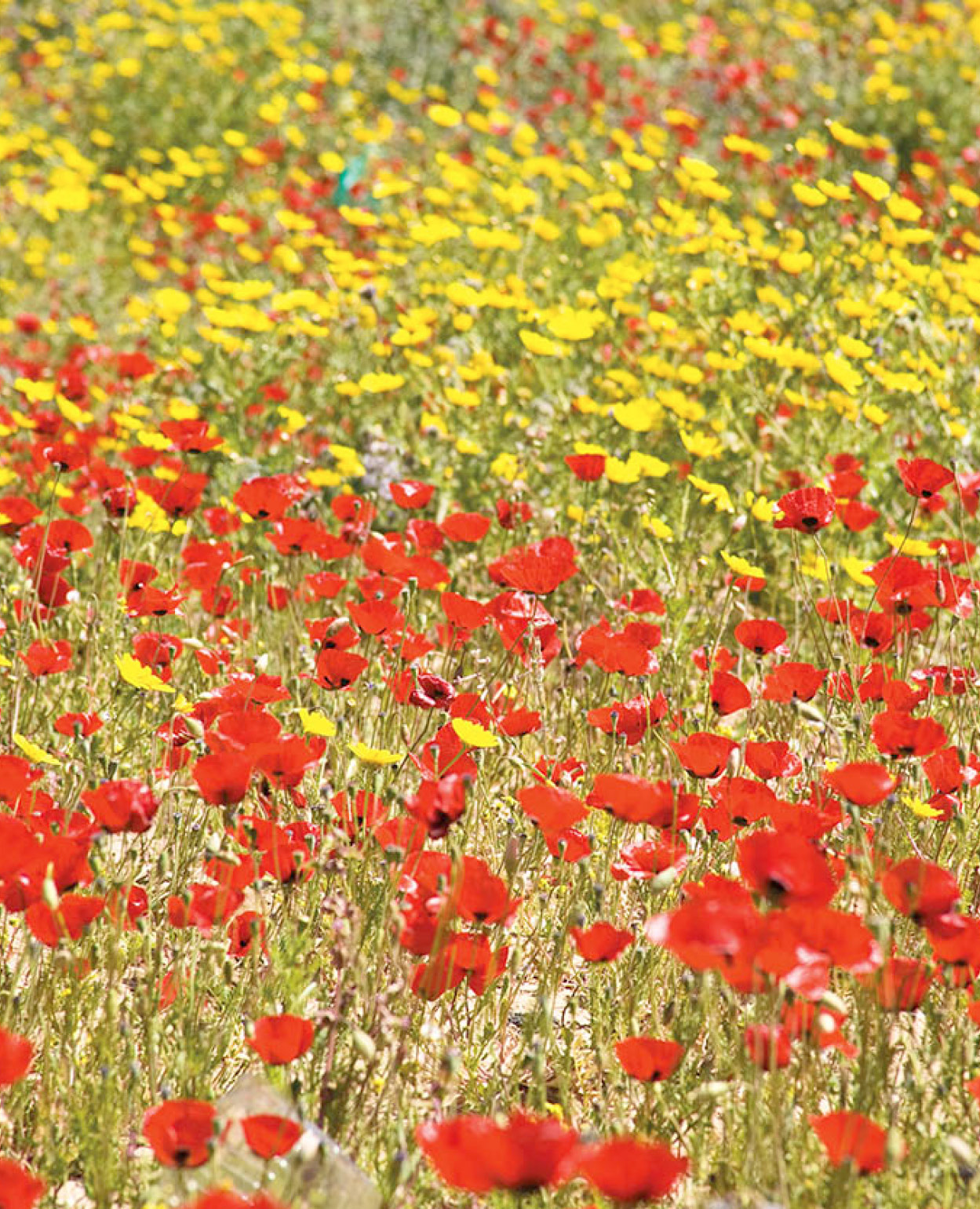
The mountains of Jordan, a backdrop to Eilat.
Richard Nowitz/Apa Publications
Eilat is Israel’s southernmost community. It is the state’s flipper-hold on the Red Sea. It is also a mecca (if such a word can be used in Israel) for snorkelers, scuba-divers, windsurfers, water-skiers, swimmers, sailors, sandcastle builders, sun-worshipers, tropical-fish fanatics, and birdwatchers.
Eilat’s single significant industry lies in assisting visitors to do nothing productive. It is a sensual city, which caters for people who like magnificent natural beauty, lazy afternoons, spicy food, and cold beer. To help keep prices down, the Israeli government has made Eilat a free-trade zone, which means it has no sales tax (VAT) and many items are cheaper than elsewhere in the country – although overseas visitors are anyway exempt from this tax for expensive goods and services paid for with foreign currency. If you rent a car, make sure to fill up with gasoline in Eilat only, as VAT is charged outside of the city.
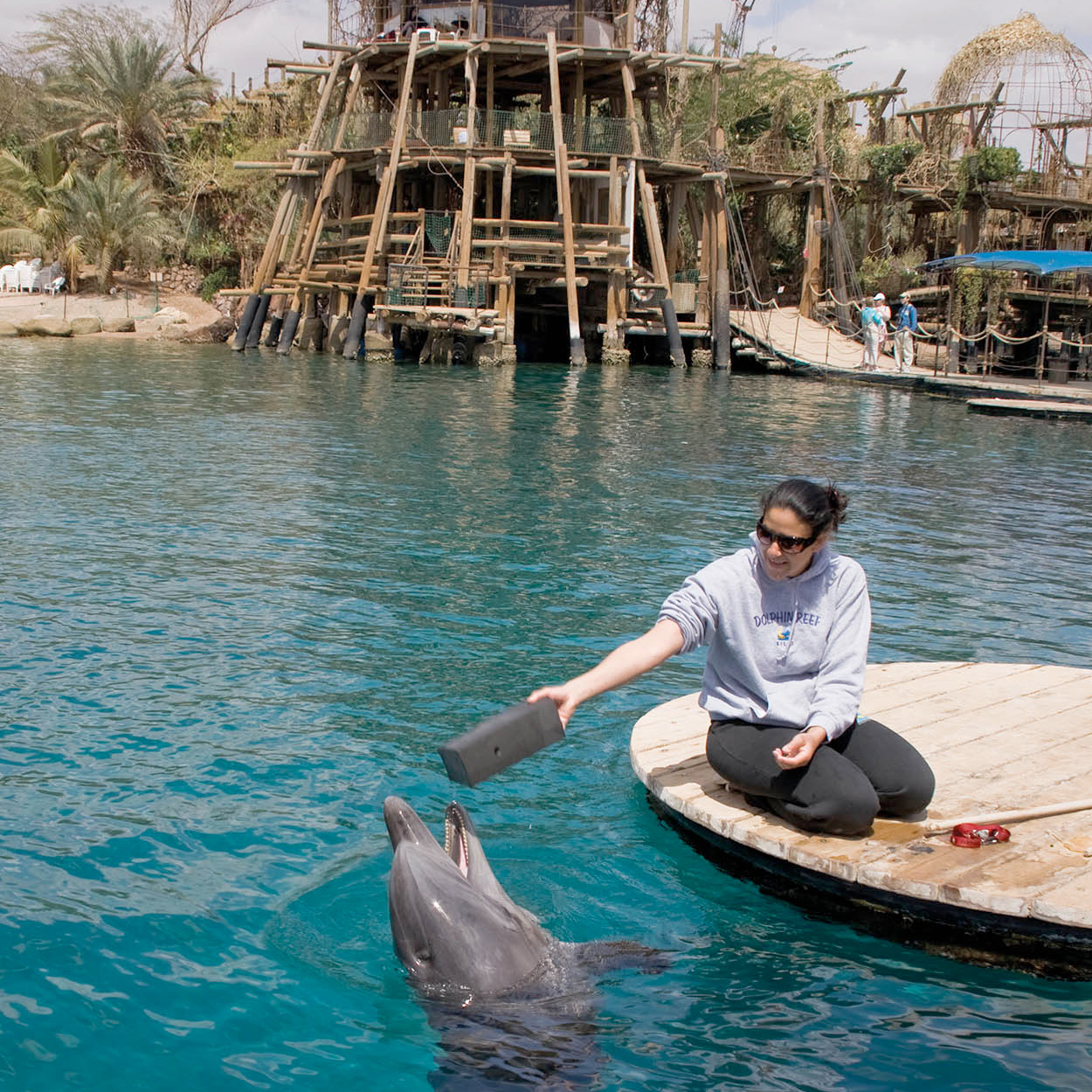
Dolphin Reef, Eilat.
Richard Nowitz/Apa Publications
First City
Eilatis whimsically call their town Israel’s “First City” because it was the first piece of land in what is now Israel to be occupied by the Children of Israel after the Exodus from Egypt (Deuteronomy 2:8). But Moses was only a tourist; he moved north to find milk and honey soon afterward.
A few centuries later King Solomon built a port here and called it Etzion Geber. With the help of his friend King Hiram of Phoenicia, he sent a fleet of ships east to the land of Ophir, “and fetched from thence gold, four hundred and twenty talents, and brought it to King Solomon” (I Kings 9:26). Since there were about 3,000 shekels to the talent, and about a half-ounce to the shekel, the sailors must have lugged some 20 tonnes of gold back to Jerusalem.
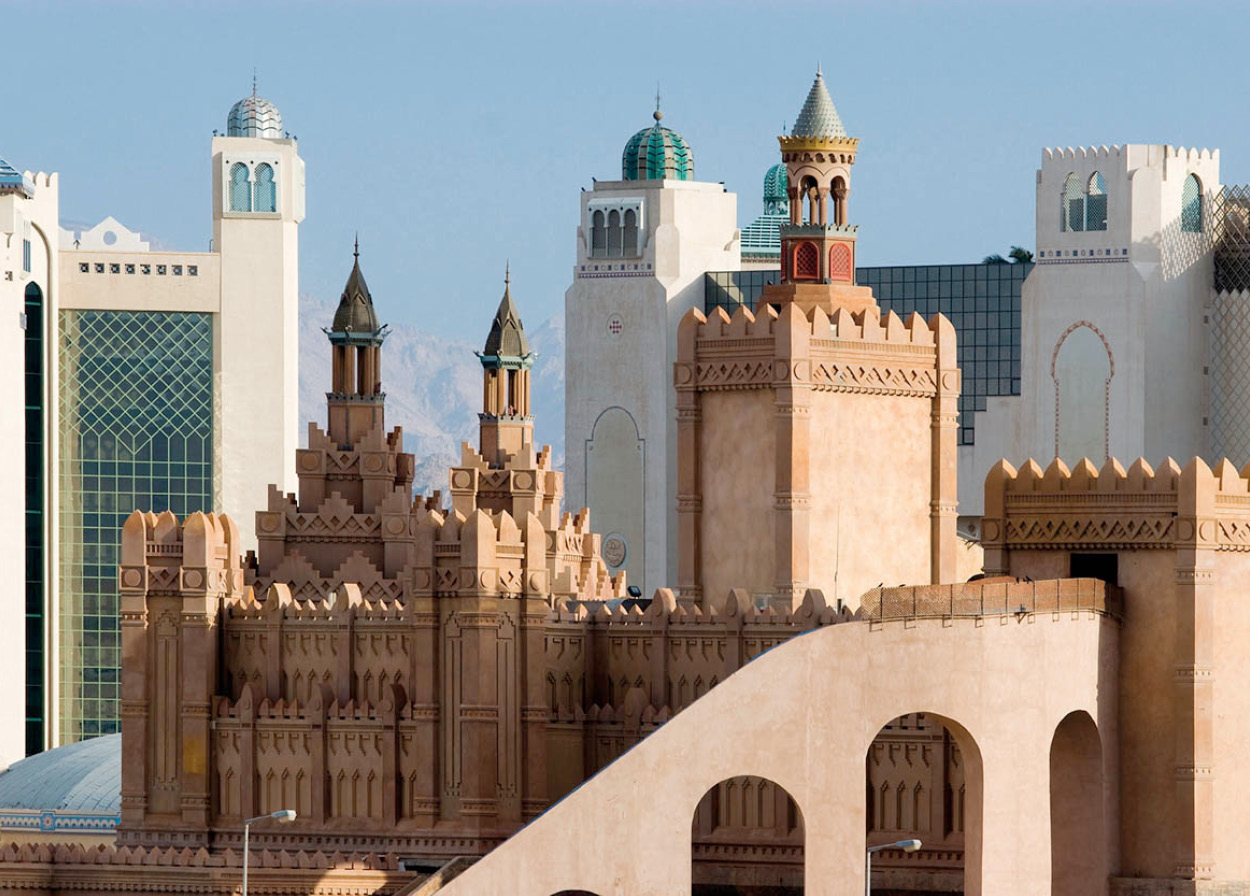
In the foreground, the turrets of Kings City.
George M Muresan/iStockphoto
Eilat changed hands many times during the following centuries. The Edomites grabbed it for a while, and then King Uzziah took it back for the Israelites. The Syrians later wrested it away from him. A succession of conquerors marched through – Nabateans, Greeks, Romans, Mamelukes, Crusaders, Ottoman Turks, and others. The Crusaders left behind their 12th-century fortress at Coral Island, just south of Taba. The celebrated Colonel T.E. Lawrence, popularly known under the moniker Lawrence of Arabia, trekked through these parts after his conquest of Aqaba across the bay, which is believed to be the biblical Etzion Geber.
The most recent army to conquer Eilat was the Israel Defense Forces, which swooped down on this exotic pearl during Operation Uvda in March 1949 and scared the daylights out of several sleepy lizards and a tortoise living in the ruins of Umm Rashrash – an otherwise uninhabited mud-brick “police station,” which stood all alone in what is now the center of the town. Although the United Nations had allocated Eilat to Israel in its partition plan, the capture of this corner of the Promised Land in the War of Independence was so hastily organized that Israeli troops arrived without a flag to proclaim it as part of their new state. So, a soldier with artistic talent was issued a bed sheet and a bottle of blue ink with which to produce an Israeli flag of appropriate dimension and design.
FACT

A celebration in Eilat’s hotel district.
Israel Tourism
Development town
The new flag didn’t fly over very much, but the Israeli authorities knew that Eilat was located in a highly strategic position, and rapid steps were taken to create a town. It was strategic because it provided Israel’s only access to the Indian Ocean, and trade with Asia, East Africa, Australia, and Oceania, including the vehicles and other manufactured goods on offer from Japan, Korea, and China. Holding on to Eilat also meant a break in land continuity between Egypt and Jordan, thus offering a military advantage to the defense forces.
In the rush to create a city on the Red Sea, Eilat’s builders, as throughout Israel, didn’t invest much in fine architecture. Instead, they went for fast, simple, sturdy construction of apartments to house immigrants trickling in after the horrors of Nazi-occupied Europe, and the expulsions by Arab states such as Iraq and Yemen. Visitors to Eilat can see some of the older 1950s apartment buildings still standing like concrete bastions on the hillside. They’re still quite serviceable, and are occupied by Eilati families who have affectionate nicknames for them, such as “Sing Sing,” and “La Bastille.”
Crisis and boom
Egypt’s President Gamal Abdel Nasser also realized the strategic value of Eilat and its potential as a multimillion-dollar tourist playground. In May 1967 he imposed a blockade on Eilat and shut down its shipping, including the then vital oil supplies from Iran, by closing off the Strait of Tiran at the tip of the Sinai peninsula. Next, he ordered the UN peace-keeping forces out of Sinai and moved his own army into the mountains northwest of Eilat, within clear view of Jordan. With one quick push, the fear was, he could have cut off Eilat, linked up with the Jordanian Arab Legion and created a solid, integrated southern front against Israel. Eilat was in an extremely vulnerable position until the Israeli pre-emptive strike against Egyptian airfields deprived Nasser of the vital air cover his troops would need. The following six days witnessed Israel’s lightning conquest of Sinai, and the removal of military threats against Eilat.
FACT
The dolphins at Dolphin Reef enjoy human company. In the 1990s a group of very pregnant British women came out to give birth in the sea with the dolphins, but the Israeli Ministry of Health refused to allow the women to do so.
Even after 1967, Eilat didn’t really take off as a tourist destination. For most Israelis it was a stop-off point en route to Sinai, where the desert was more dramatic and the diving and marine life even more remarkable. The return of Sinai to Egypt in 1982 and growing affluence in Israel enabled Eilat to begin to grow. And grow it has. Today the city has about 75 hotels, including many of the major international chains.
Most of the tourists are Israelis, who drive the four-hour trans-desert trek from Jerusalem and Tel Aviv for their vacations and can withstand average summer temperatures of 40°C (104°F). But many others, especially in winter, are foreigners who take charter flights from Europe directly to Eilat. Arkia, Israel’s domestic airline, also operates several flights a day from here to other cities in Israel, and the Sinai.
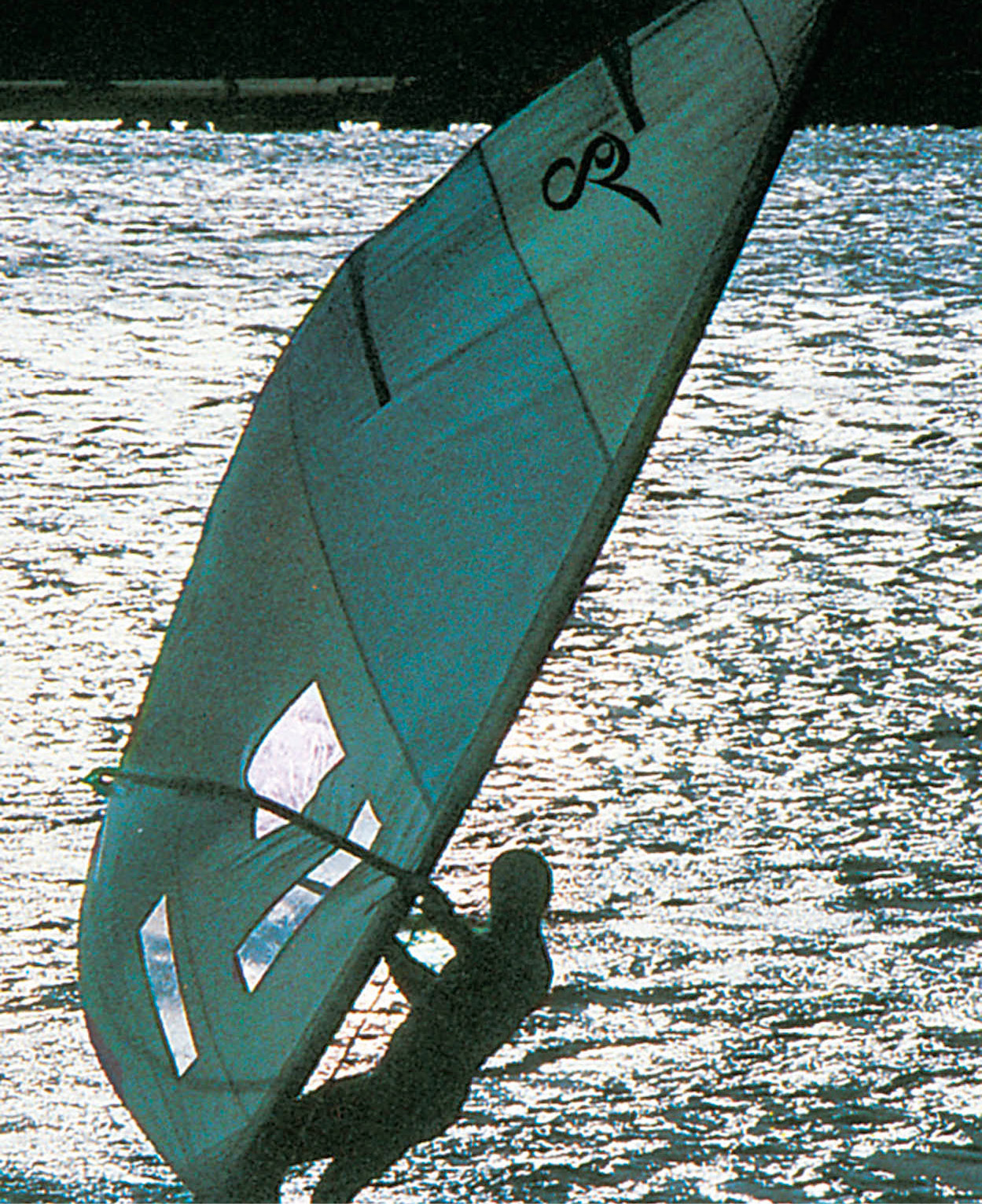
Windsurfing at dusk.
Richard Nowitz/Apa Publications
Plenty of rocks
An adage grew up among Eilatis, “If we could export rocks, we’d all be millionaires.” The key to Eilat’s tourism has been to twist the adage to bring the foreigners to the rocks. Nearly all of these rocks are pre-Cambrian, formed by the forces of the earth in the epochs before the beginning of life on the planet. Aeons ago they covered the land facing the north, where the ancient Tethys Sea flowed over what is now the State of Israel.
To the south extended the primordial megacontinent of Gondwanaland, which eventually drifted apart to form India, Africa, South America, Australia and Antarctica, and the bed of the Tethys Sea was pushed up to form the bedrock of Israel. Geologists are forever pottering about the Eilat mountains, picking at chunks of granite, gneiss, quartz-porphyry and diabase. In some places they are after an attractive bluish-green malachite, which merchants in town call Eilat Stone, a type of copper ore that can be shaped and given a high polish. In fact, this stone has been used in jewelry-making in the region for thousands of years, and is still very evident in many Eilat tourist shops.
For those who like to see their rocks in the rough, there are the Eilat mountains, spectacular ascents of colorful stone. In some areas it appears as if their volcanic genesis was fast-frozen, and their flowing magmas interrupted in full flood. Erosion here has taken some bizarre and incredibly beautiful courses. In places it is possible to walk through narrow canyons with walls towering hundreds of meters vertically, but just a meter or two apart. The harsh desert wind has carved monumental pillars among the mountains, particularly in the sandstone regions, such as the Pillars of Amram (named after the father of Moses), some 9km (5 miles) north of Eilat and 3km (2 miles) west of the main highway. The site is laced with lovely ravines and clusters of imposing natural columns.
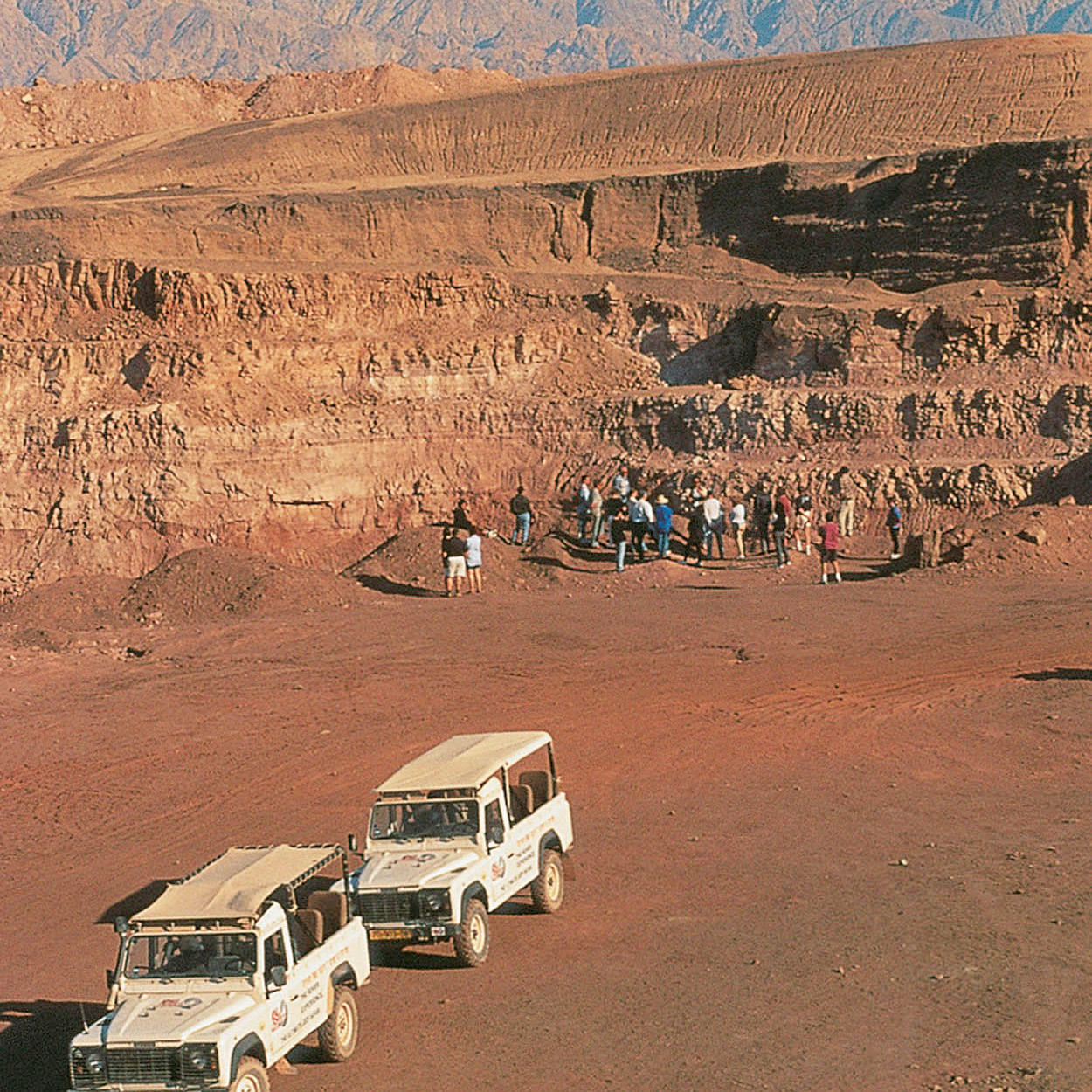
Geological field trip.
Richard Nowitz/Apa Publications
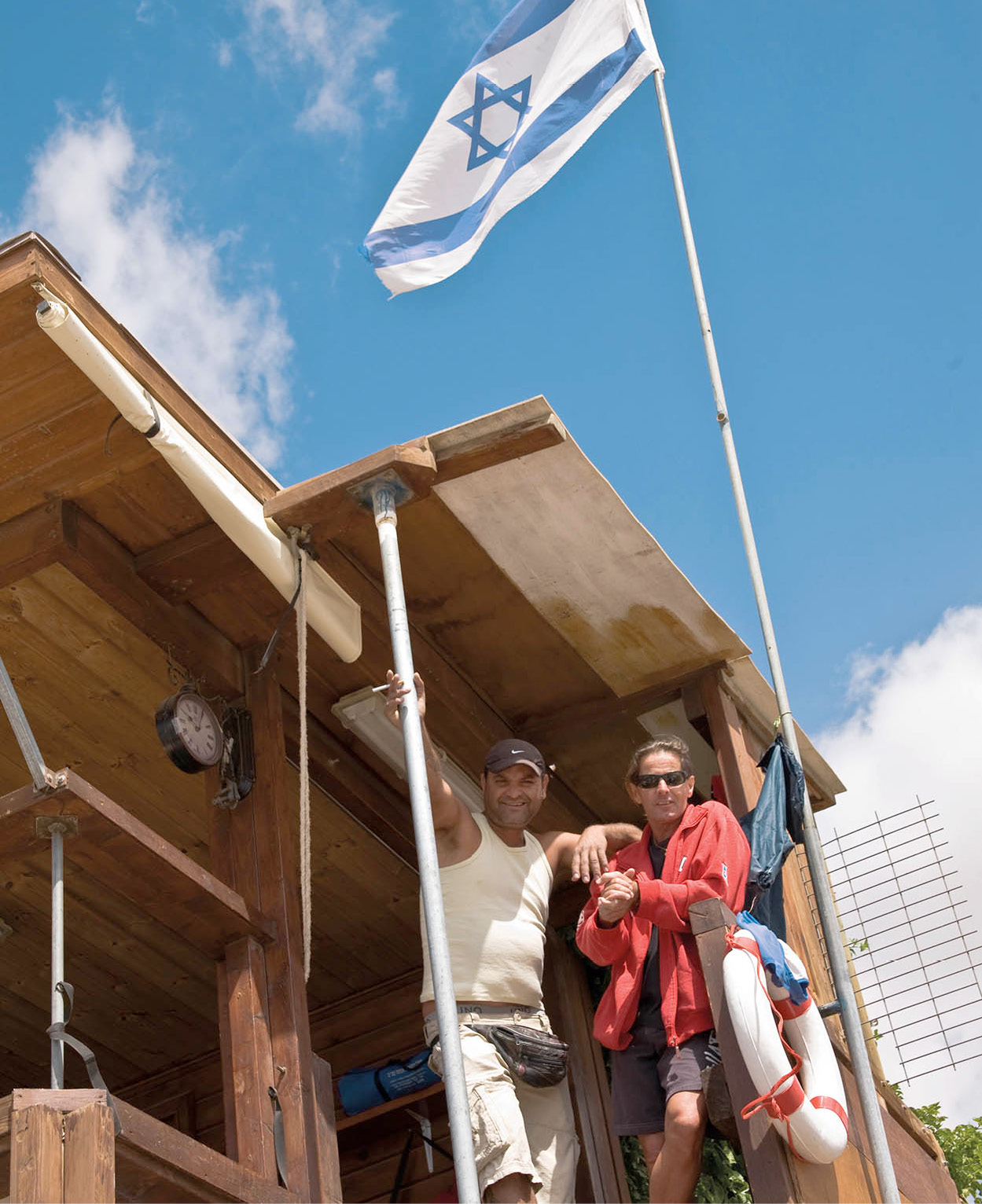
Manning the lifeguard center at the beach.
Richard Nowitz/Apa Publications
About 4km (2.5 miles) south of Eilat, along the coastal highway leading to Sinai, is the entry to Solomon’s Canyon, a popular hiking area. A dusty granite quarry at the mouth of the canyon tends to obscure the formations lying beyond, but those following the path markers in the Harei Eilat (Eilat Mountains) Nature Reserve £ [map] will be treated to an exotic geological adventure. As you enter the canyon, Ha-Metsuda (The Stronghold) rises to the left. This great rock was vital to Eilat’s defenses against invasion from the Sinai coast. The path then leads another 16km (10 miles) up into the mountains, twisting and turning along the route of the canyon. Hikers pass first beneath Har Yehoshafat, then Har Shlomo, and then Har Uziya, each of which towers more than 700 meters (2,300ft) overhead.
Eventually the trail crosses the paved Moon Valley Highway, which leads into central Sinai. Across the highway, the trail continues on to the spectacular cliffs and oasis at Ein Netafim (The Spring of the Drops), which trickles across a barren rock into a picturesque pool at the foot of an imposing cliff. Farther along is Red Canyon, another impressive natural wonder of erosion-sculpted sandstone.
Beaches are a year-round attraction in Eilat. Even in the summer, when temperatures can range well above baking at 40°C (104°F), the waters of the Red Sea are cool and soothing. Midwinter swimming, however, is usually left to the Europeans and Americans, while native Eilatis stare from the shore, bundled up in parkas to dispel the wintry gusts, which usually hover at around 18°C (roughly 64°F).
Eilat has a number of distinct and attractive beaches, stretching 11km (7 miles), ranging from fine sand to gravel. North Beach A [map], close to the center of the town and to the west of the marina and lagoon, is the local hangout for sun-worshipers. The bay is protected, the swimming is easy, and dozens of hotels line the shore. The eastern end of North Beach also has inexpensive bungalows and even camping facilities for those on a tight budget.
Farther south is Dolphin Reef B [map] (Sun–Thur 9am–5pm, Fri–Sat until 4.30pm; tel: 08-630 0111; www.dolphinreef.co.il; charge), a private beach where you can swim with the dolphins. If you have a license you can hire diving equipment and dive with them too. There are qualified guides to accompany divers. The dolphins are very friendly – so much so that they are sometimes used in therapeutic programs for children with disabilities.
TIP
You can learn to dive while in Eilat: several schools advertize prominently in the town.
A little farther down the coast, past the navy station, port facilities, and vast lots containing tens of thousands of imported cars from Japan and Korea, many of which are transported to Europe, is Coral Beach Nature Reserve C [map] (daily 9am–5pm; tel: 08-637 6829; charge). This reserve includes a fine sandy beach and a truly spectacular coral reef. Here visitors can rent diving masks, snorkels, and flippers from the reserve’s office and swim along any of three marked routes, which lead over different parts of the coral reef. Special markers set into the reef itself identify different types of coral and plants growing there, as well as some of the more common fish.
The reserve also has changing rooms, showers, snack and souvenir stands, and other tourist amenities. But tourist-friendly though it may be, this is a monitored nature reserve. Swimmers must be very careful not to bruise any of the coral. Removal of any pieces of coral is taken very seriously indeed and will result in the culprit paying a visit to the local judge.
Conservationists recently won a major victory near here, when the courts ordered fish farmers to remove their underseas fish cages because the fish feces were damaging the surrounding coral reefs.
Observing fish
Farther south is the Underwater Observatory Marine Park D [map] (Sat–Thur 8.30am–5pm, Fri 8.30am–4pm; tel: 08-636 4200; www.coralworld.com; charge), an unusual commercial aquarium and undersea observatory. Here the visitor walks out on a long pier to the observatory building, which is set into the reef itself. Descending the spiral staircase within the observatory, one emerges into a circular room with windows facing out into the coral reef at a depth of 5 meters (16ft). All sorts of fish swim freely about outside the window, and the many colors and shapes of the living reef are astonishing sights that should not be missed.
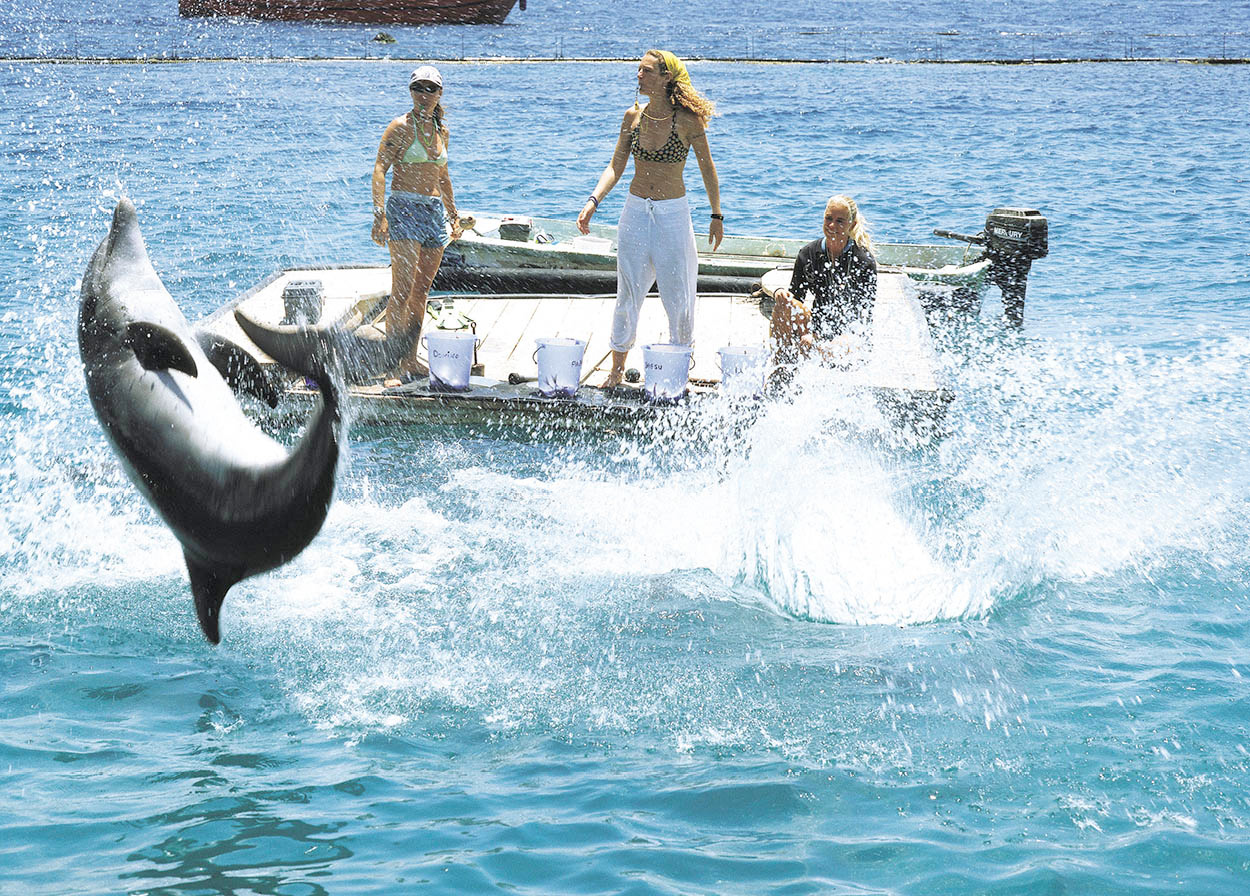
Fun with the dolphins.
Israel Tourism
There is also a museum, which exhibits the marine life and coral on a comprehensive A–Z basis, a shark tank, and, for an extra charge, a yellow submarine, the Jacqueline, which will take you on one-hour underwater trips. Nothing quite as lovely has been seen since Jules Verne’s Captain Nemo retired the Nautilus. Also, for an additional charge, the Oceanarium offers a 3-D cinema show with a screen surrounding the viewer, while even the seats move.
Those who abjure actually going into the water might be more inclined to ride on it instead. A large marina and lagoon at North Beach is the mooring for many boats and yachts, from expensive charter schooners to more affordable windsurfing craft. There are also several glass-bottomed boats for reef-viewing, and a number of water-skiing speedboats available for charter. Licensed diving clubs, which will rent diving equipment and offer diving courses, include Lucky Divers, Red Sea Divers, and Eilat Aqua Sport.
Observing birds
Birdwatching, too, is a year-round attraction in Eilat, and several dozen species of resident bird can be found in the mountains and deserts, by the seashore, and among the fields of neighboring Kibbutz Eilot. The spring migration season, however, is particularly dazzling and is the best time to be here. Millions upon millions of migratory birds fly across the Eilat region on their northward journeys from warm wintering havens in Africa to their breeding grounds scattered across Eurasia. Great waves of eagles and falcons fill the sky, and highly respected ornithologists keep producing reports giving strangely precise figures, such as 19,288 steppe eagles, 26,770 black kites, and 225,952 honey buzzards in the course of a single migration season.
Sharp-eyed birdwatchers will also pick out booted eagles, snake eagles, lesser spotted eagles, imperial eagles, marsh harriers, sparrowhawks, and osprey. And then come the pelicans and storks in their tens of thousands. There is a ringing and birdwatching center north of North Beach near the salt flats, where many of the migrating birds stop off for a nibble after traveling across the sea and/or desert. Numbers of migrating birds observed have been down in recent years, but no obvious explanation has yet been found.
For those looking for a leisurely vacation there are scores of restaurants here, ranging from inexpensive pizza parlors and falafel stands, through reasonably priced places selling very good seafood, to high-priced haute cuisine in the Eilat Center, the New Tourist Center, and the Hotel District. Most of the larger hotels also have nightclubs, discos, and other entertainments. The Red Sea Jazz Festival each August has become an annual summer fixture, drawing thousands of jazz fans to several nights of live entertainment by local acts and international stars.

The Treasury (El Khazneh), Petra, Jordan.
Yadid Levy
Aqaba and Petra
In the wake of the Middle East peace process, Eilat has become a popular base for visits to Sinai in Egypt and Petra in Jordan. The region is marketed as a Middle Eastern French Riviera, and the region’s tourist industry is flourishing.
The Arava Crossing to Jordan, northeast of Eilat, has offered access to the Hashemite Kingdom since the peace accord was signed between Israel and Jordan in 1994. The frontier can be reached along a road running eastward off the main Arava highway several kilometers north of Eilat, not far from Kibbutz Eilot. The Arava Checkpoint is open Sun–Thur 6.30am–8pm and Fri–Sat 8am–8pm. It is closed on Yom Kippur and Id el Fitr. Passport holders can enter Jordan without a visa if they pay a US$10 charge. It is not yet possible to take vehicles from Israel into Jordan, but bus 16 leaves Eilat Central Bus Station once an hour for the border crossing.
Magical Petra
Petra is far and away Jordan’s most spectacular touristic site, offering a powerful and always invigorating combination of Nabatean antiquities and sensational natural scenery. From sunrise to sunset, its footpaths bustle with tourists, yet an uncanny otherworldliness prevails. In the very midst of what was obviously a thriving city, the Nabateans built a host of elaborate funerary monuments. These, combined with the intense glow of the rock and prolific references to gods, animals, and mythological beings, create an almost supernatural aura. The city was all but abandoned by the late 8th century, yet the details of the monuments appear amazingly fresh. A full week is required to see every important part of the Petra Basin, which in its entirety comprises nearly 100 sq km (38 sq miles).
The town of Aqaba $ [map] is unexceptional. Sitting alongside Eilat on the northern shore of the Red Sea, Aqaba is Jordan’s only outlet to the sea and therefore a busy port. The tourist infrastructure here is much less significant than in Eilat, making the beaches quieter. The name Aqaba was given to the town in the 14th century by the Mamelukes, and it was the first town captured from the Turks in 1917 by the Arab forces led by T.E. Lawrence (Lawrence of Arabia).
FACT
In 1845 Petra was immortalized in a poem by the English cleric John W. Burgon, in which he described it as “a rose-red city, half as old as time.”
By far the most popular excursion into Jordan involves traveling northward some 120km (75 miles) to the fabulous Nabatean city of Petra % [map]. Reached through a narrow canyon, Petra is best known for the dramatic tomb and temple facades carved into the Nubian sandstone mountains. The pink, red, and purple-hued mountain walls would be exquisite enough, but in addition you get the romance and history of a location that lay forgotten for nearly 2,000 years until “discovered” by the Swiss explorer Ludwig Burckhardt in 1812.
Visiting the Sinai
The Sinai was captured by Israeli forces in 1967 and returned to Egypt in 1982 under the Camp David peace treaty. It remains a popular playground for Israelis, who built up a tourist infrastructure along the Red Sea coast during the years when they held the territory. Since then the Egyptians have greatly expanded the region’s tourist facilities, but vast stretches of the Sinai remain gloriously isolated. It is more rugged and spectacular than the Negev, and everything here is on a grander scale.

Idol of the goddess Hayyan in the Petra Museum.
Nowitz Photography/Apa Publications
The Sinai can be reached from the Taba Border Crossing (tel: 08-636 0999), 10km (6 miles) south of Eilat. The Taba enclave itself, which has a Hilton Hotel with a casino, is technically in Egyptian territory, but is open to all who can produce valid passports. The crossing into the Sinai is open 24 hours a day, seven days a week, closing only for the Jewish festival of Yom Kippur and the Muslim festival of Id el Fitr. Visas for a two-week stay in the Sinai peninsula only are given at the frontier itself for a small charge, but people wishing to visit the rest of Egypt must obtain a full visa from an Egyptian Consulate in Eilat or elsewhere. Bus number 15 will take you to the border, and there are buses and taxis on the Egyptian side running through Sinai and on to Cairo. Passenger cars can be taken into the Sinai for a modest charge.
TIP
In the Sinai and Negev, take heed when Bedouin warn of flash floods in the winter. The skies may be clear, but heavy rains can sweep down through dry canyons and river beds. The Bedouin, smelling the rainwater in the air, know what’s coming.
Note that there have been security incidents in Sinai since the political upheavals in Egypt in February 2011, and it is advisable to check the latest security situation before entering the peninsula.
Sharm al-Shaykh
There are three major resorts along the Sinai’s Red Sea coast: Nowibe 1 [map], 60km (38 miles) south of Eilat, Dahab 2 [map], 135km (85 miles) south of Eilat, and Sharm al-Shaykh 3 [map], 225km (140 miles) south of Eilat. You can stop en route to eat fresh fish in one of the coastal villages. Desert safaris to nearby wadis and oases are offered from all these locations, but an even bigger attraction than the stunning desert landscapes is the marine life, and the coral reefs especially.
The Sinai is considered one of the world’s premier locations for divers. Generally speaking, the coral formations are more remarkable to the south, with Sharm al-Shaykh being the favorite choice of seasoned divers. Conservationists are increasingly concerned about the harm caused to coral at Ras Muhammad National Park; this is mainly due to over-harvesting and damage from ships’ anchors, but also to illicit souvenir-hunting.
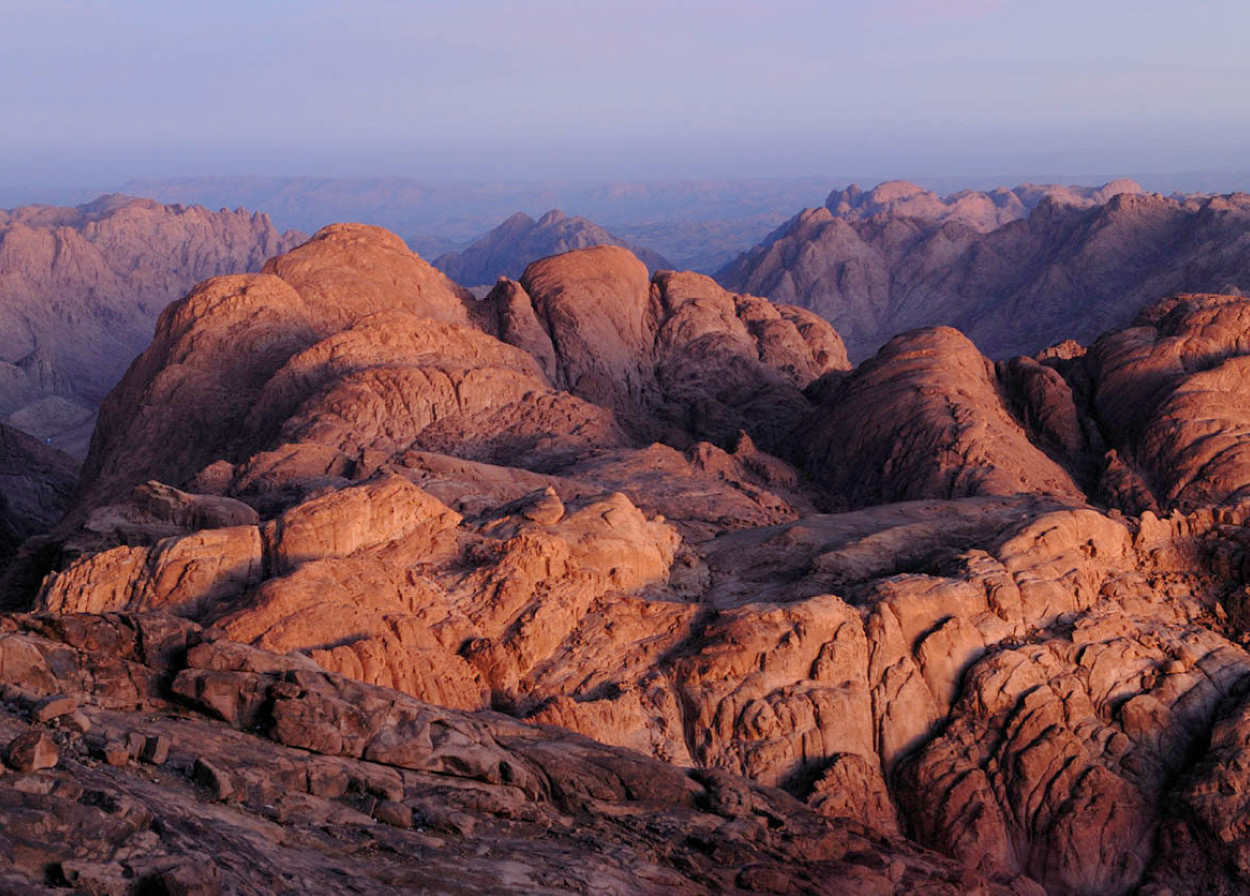
Mount Sinai just before the break of dawn.
iStockphoto
St Catherine’s and the Chapel of the Burning Bush
The other major attraction of Sinai is St Catherine’s Monastery 4 [map] (daily 9.30am–noon; closed public holidays), reached from a road running southwest for 35km (21 miles) from a point located midway between Nuwayba and Dahab. Built by funding from the Byzantine ruler Justinian in the 6th century on a site where some believe the burning bush spoke to Moses, the monastery is today home to Greek Orthodox monks. It has a magnificent basilica and a splendid fresco depicting the transfiguration of Christ. The tiny Chapel of the Burning Bush stands on the spot where the biblical event is said to have taken place.
The nearby summit at an altitude of 2,642 meters (8,660ft) offers a breathtaking view of the desert.
All-inclusive tours to both the Sinai and Petra involving overnight stays are available from the many travel agents in Eilat. As the price and content of these tours vary a lot, it is worth shopping around for the best value.
Diving in Eilat
Beautiful coral reefs, clear waters and swarms of tropical fish, coupled with a reputation for safety, have made Eilat a top diving destination
Eilat is one of the world’s top destinations for warm-water diving. What makes its marine environment especially magical are the exquisite coral reefs, the colorful and remarkable array of tropical fish, and the clarity of the water, with average underwater visibility of 30 meters (100ft). An extra incentive to visit Eilat is the 350 days of sunshine a year.
Expert divers consider diving in the Sinai in Egypt to the south of Eilat to be much better, but the tourist infrastructure there is less well developed. Moreover, Eilat’s lack of currents, due to its location in a sheltered bay at the northern end of the Red Sea, combined with the shallowness of the reefs, greatly reduces the dangers associated with diving. It also means that Eilat is nicknamed the “underwater classroom” because of the large numbers of budding divers who flock to the resort to learn the skills of scuba-diving.
The safety factor is also enhanced by the fact that diving in Israel is strictly regulated by Knesset legislation. It is a criminal offense for any of the several dozen diving equipment businesses in the city to rent out equipment to a person who can’t present a valid diving license issued by an internationally recognized organization such as PADI (Professional Association of Diving Instructors).
Most of the diving clubs are located near Coral Beach, several miles south of the city center. If you do not have a license, then a typical diving course for beginners comprises five full days of instruction, from classroom theory through to pool training and ultimately the real thing.
The less adventurous need not be denied the fantastic spectacle of Eilat’s underwater world. Snorkeling is simple to do. Simply buy or rent a snorkel, wade in and stick your head under water. Alternatively, many of the diving clubs have snorkeling tours – a bit like a nature hike with a professional guide.
There are dozens of other ways to enjoy the Red Sea from above the water. The bay’s strong breezes are ideal for windsurfing, and for those who prefer to travel faster there is no lack of water-skiing (including jet skis, tube skis and bob skis for the initiated). If you don’t want to get your feet wet, then you can hire a kayak, canoe, rowing boat, or speedboat, while a glass-bottomed boat is ideal for appreciating the marine life.
There is also the yellow submarine, located inside the Underwater Observatory Marine Park. The Marine Park itself is probably the best place for non-divers to enjoy Eilat’s incredible underwater seascapes.
Practical information
For renting diving equipment or taking courses it is best to head for Coral Beach:
Aqua-Sport: P.O. Box 300, Eilat; tel: 08-633 4404; www.aqua-sport.com; email: info@ aqua-sport.com.
Red Sea Lucky Divers: P.O. Box 4191, Eilat; tel: 08-632 3466; www.luckydivers.com; email: luckysue@luckydivers.com.
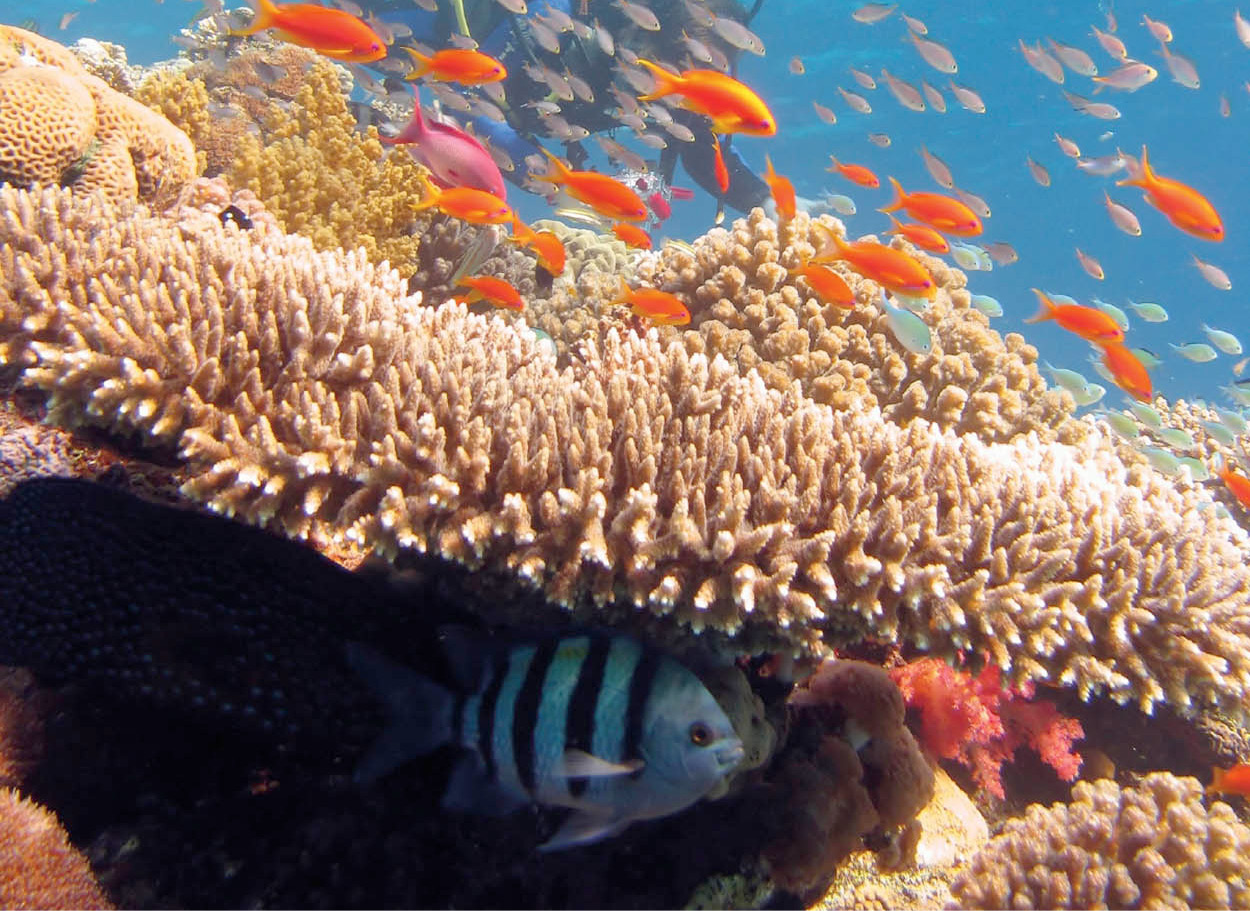
The lack of currents and the shallowness of the coral reef make diving relatively safe.
Elisei Shafer/iStockphoto